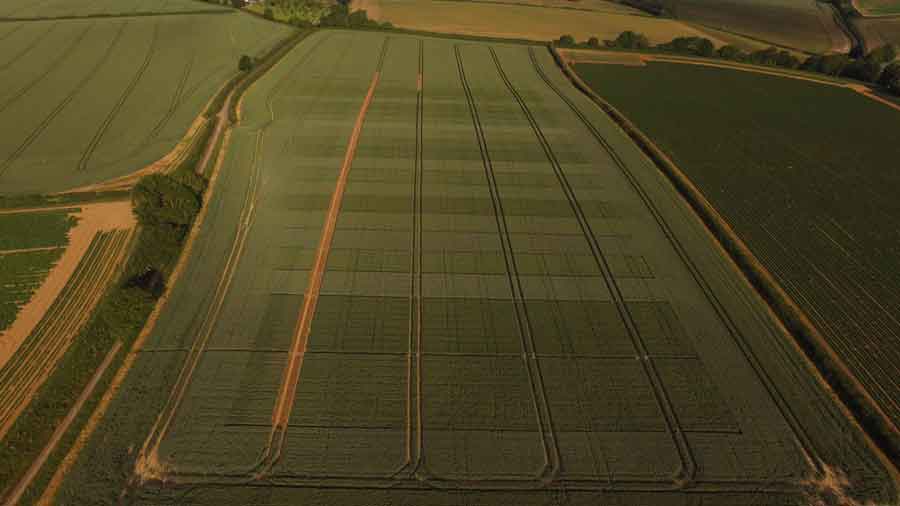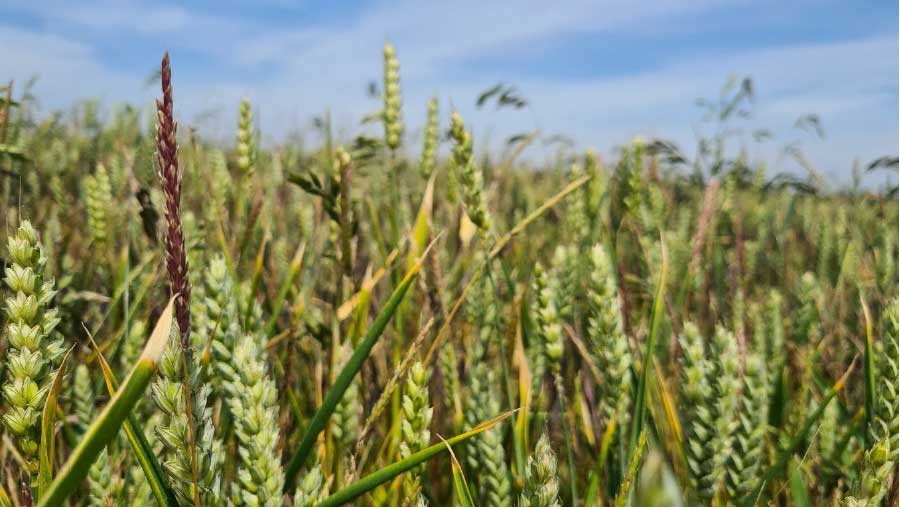Advertiser content
Relentless approach reduces blackgrass returns
 Hurcott Farm © BASF
Hurcott Farm © BASF The 2023/24 season maybe one that many farmers would like to forget. However, that may prove tricky because the mild, wet winter created the worst situation – ideal conditions for blackgrass growth, and very difficult conditions for crops.
The high level of grassweed seed return is incredibly challenging and will take years to bring back under control.
But, with patience, a long-term perspective and strategic IPM use, it is possible, as Somerset grower Mark Doble has discovered.
Thick with RRR resistant blackgrass
“Back in 2016 our landlord took back two fields of Grade 3 arable land for solar, and, in return, offered 17.5 hectares of Grade 2 arable land,” explains Mark.
“It seemed like a reasonable exchange; however, these fields came with a very high blackgrass population.”
Hurcott Farm, near Ilminster in Somerset, comprises 160ha on which Mark grows a mixture of winter wheat, oilseed rape, winter linseed, maize and potatoes, and makes the most of his seed contract by aiming for 50% break crops and 50% wheat.
“The presence of blackgrass was a significant problem for us. The rest of the farm is kept free from the grassweed so that seed crops can be grown.”
Resistance testing of the blackgrass in the two new fields found RRR resistance to ALS herbicides. It was so bad that Mark recalls “in places it looked like a grass field.”
A battle of attrition
In the first year, these fields were hand-rogued. “It took four people a week,” says Mark.
“To avoid contaminating our combine, it was harvested as whole crop for the local anaerobic digestion (AD) plant. Any other machinery used was then rigorously cleaned.”
As wheat for whole crop is harvested earlier than normal, in both 2017 and 2018 Mark had a good window to generate stale seed-beds to tackle the weed out of the crop and in the subsequent springs grew maize crops for the local AD plant.
According to Richard Guest, the local BASF Agronomy Manager, it was a wise decision.
“Maize is a good crop for gaining the upper hand against blackgrass,” he says.
“It presents an opportunity to get multiple stale seed-beds ahead of drilling in April or May. By then, any germinating blackgrass tends to be weaker and not as prolific in its seed set.”
“It also allows you to use different chemistry; it’s a useful rotational tool,” he adds.

© BASF
Using different herbicides in the maize crops to those historically applied in cereals ‘did the job’, Mark noted.
Hurcott Farm is dominated by two main soil types – sand, which has a habit of slumping, and sandy clay brash, which can become “as hard as concrete.”
Both need some form of primary cultivation to get air back into the ground and also avoid wet patches, which blackgrass thrives in, so Mark subsoiled after both maize crops in 2017 and 2018.
The following year, Mark put the acreage into winter wheat.
Despite a robust herbicide programme of Herold (flufenacet and diflufenican), Xerton (ethofumesate) and Trooper (flufenacet and pendimethalin), followed by Pacifica (mesosulfuron and iodosulfuron), large patches of the grassweed were left to be rogued, a likely factor of the historical resistance.
For harvest 2020, the hectarage was returned to maize once again, facilitating windows for stale seed-beds and out of crop control. Autumn 2020 saw a return to winter wheat.
“In May 2021 we witnessed first hand the background level of weed seed present.
“Whilst applying the autumn residual herbicide mix, I ran out part way down a tramline, and a quirk of the GPS system meant that when I restarted, I left a 2m deep miss, the full 24m width of the sprayer!
“The huge level of weed infestation in this patch led us to spray off the area with glyphosate.” This wheat crop was also destined for the AD plant as wholecrop.
Following this wheat crop Mark grew winter barley for harvest 2022, utilising cultural control alongside his chemical control.
“As we have done previously, we drilled as late as possible, applied a robust residual herbicide mix and then subsequently rogued it again that year.
“I felt as though we must be starting to get on top of the population as we didn’t find much blackgrass to rogue at all,” he says.
“Although, this crop was originally destined for AD, the low levels of blackgrass and with grain prices at over £300/tonne, we decided to harvest the grain and straw. To avoid any contamination of our combine we got a contractor in to cut it.”
The following year, Mark grew oilseed rape. “We chose a Clearfield variety, InV1266CL, which enabled us to use different chemical groups and modes of action, applying Cleravo (imazamox and quinmerac) for general weed control, as well as Kerb Flo (propyzamide) to really hit the blackgrass,” he explains.
Winning the blackgrass battle
This year, the field has returned to winter wheat. Mark grew the variety Champion as it is known to be competitive.
Stale seed-beds were again exploited, and he delayed drilling the crop until the 9th October 2023.
“Drilling is always a balancing act,” acknowledges Richard. “The effects of delaying drilling on blackgrass are huge; the control you can achieve with robust chemistry equates to delaying drilling by around four weeks.”
“At trials with Niab in Hardwick, the treated plot drilled in September had comparable levels of blackgrass to the untreated plot drilled in October.
“It is a really important tool and Mark’s decision to delay drilling to mid-October is the right one.”

Richard Guest © BASF
Less than a day after sowing the crop, Mark applied Luxinum Plus (cinmethylin) + Stomp Aqua (pendimethalin) and Hurricane (diflufenican).
For Richard, this was key –“not only is applying the best herbicide for blackgrass control vital, doing so soon after sowing optimises the herbicide performance”.
“Having got his Luximo on at pre-emergence, thus using the most effective chemistry first; if the need arose and conditions allowed, Mark has the option to return with follow-up treatments early post-em.
With the climate as it is, there’s a significant risk of jeopardising the whole programme by applying less effective products first, and hoping that the weather will hold out long enough to return with Luximo.”
Continuing with his zero-tolerance approach, Mark again walked the fields in order to hand rogue the area.
“Over the 17.5 ha, all we could find was six plants, so I’m thrilled to bits,” he says. “Though for economic reasons I would have drilled a seed crop if I’d have known we’d have achieved such good control!”
For Richard, Luximo® has just been the final piece in the puzzle – it’s Mark’s persistence that has been the real winner.
“We’ve only got to this point because Mark has been ruthless in deploying IPM strategies.
“Taking wheat for wholecrop rather than combining, utilising spring cropping and stale seed-beds.
“Plus being strategic with his use of chemistry, using different modes of action and still retaining hand rogueing as a last resort.
“Luximo has brought another mode of action to the battle, and it’s that different chemistry that has helped put Mark on the winning side.
“But we must remember it is not a silver-bullet,” he hastens to add. “The reason it has worked so well for Mark, is that it has been used as part of a wider long-term IPM strategy.
“The combination of all the cultural methods that Mark has employed along with Luximo is an outstanding example of what can be achieved.”
Visit our website to find out more.
Provided by
BASF offers renowned and innovative fungicides, herbicides, insecticides and growth regulators for agriculture. Our products and services help farmers increase their yields and optimize the quality of their products.
